lookup
sequential search
Sequential lookup of unordered tables
def sequentialSearch(alist, item):
pos = 0
found = False
while pos < len(alist) and not found:
if alist[pos] == item:
found = True
pos += 1
return found
testlist = [3, 8, 5, 9, 7]
print(sequentialSearch(testlist,5))Sequential lookup of ordered tables
def orderedSequentialSearch(alist,item):
pos = 0
found = False
stop = False
while pos < len(alist) and not found and not stop:
if alist[pos] == item:
found = True
if alist[pos] > item:
stop = True
pos += 1
return found
testlist = [10, 20, 30, 40, 50, 60, 70]
print(orderedSequentialSearch(testlist,35))Two point search
It is also a divide and conquer strategy, which is to split the ordered table into two parts and search in a small range after splitting.
def binarySearch(alist,item):
first = 0
found = False
last = len(alist) - 1
while first <= last and not found:
print(first, last)
midPos = (first + last) // 2
if item == alist[midPos]:
found = True
else:
if item < alist[midPos]:
last = midPos - 1
else:
first = midPos + 1
return found
testlist = [10, 20, 30, 40, 50, 60, 70]
print(binarySearch(testlist, 35))Recursive solution of binary search
def binarySearch2(alist,item):
if len(alist) == 0:
return False
else:
midPos = len(alist) // 2
if item == alist[midPos]:
return True
else:
if item < alist[midPos]:
binarySearch2(alist[:midPos], item)
else:
binarySearch2(alist[midPos+1:], item)
testlist = [10, 20, 30, 40, 50, 60, 70]
print(binarySearch2(testlist, 20))sort
Bubble sort
The time complexity of bubbling method is O(n^2)
def bubbleSort(alist):
for passnum in range(len(alist)-1,0,-1):
for i in range(passnum):
if alist[i] > alist[i+1]:
alist[i+1], alist[i] = alist[i], alist[i+1]
testlist = [3, 8, 5, 9, 7]
bubbleSort(testlist)An optimization scheme of bubble sorting
def bubbleSort2(alist):
exchange = True
passnum = len(alist) - 1
while passnum > 0 and exchange:
exchange = False
for i in range(passnum):
if alist[i] > alist[i+1]:
alist[i+1], alist[i] = alist[i], alist[i+1]
exchange = True
testlist = [3, 8, 5, 9, 7]
bubbleSort2(testlist)
print(testlist)Selection sort
Selective sorting is an evolution of bubbling. The time complexity of comparison is O(n^2), and the time complexity of exchange is O(n), which only reduces the number of exchanges.
def selectionSort(alist):
i = 0
while i < len(alist):
j = i + 1
minIndex = i
while j < len(alist):
if alist[j] < alist[minIndex]:
minIndex = j
j += 1
alist[i], alist[minIndex] = alist[minIndex], alist[i]
i += 1
testlist = [3, 8, 5, 9, 7]
selectionSort(testlist)
print(testlist)Another solution to the choice of sorting:
def selectionSort2(alist):
for passnum in range(len(alist)-1, 0, -1):
maxIndex = 0
for i in range(passnum):
if alist[i + 1] > alist[maxIndex]:
maxIndex = i + 1
alist[passnum], alist[maxIndex] = alist[maxIndex], alist[passnum]
testlist = [3, 8, 5, 9, 7, 2]
selectionSort2(testlist)
print(testlist)Insertion sort
The complexity of inserting a collation size is still O(n^2), but the performance will be slightly better. Insertion sorting will compare the value of the previous position with the value to be inserted each time; if it is larger than the value to be inserted, it will move the previous position backward; otherwise, it will break the comparison size and insert the current value into this position. So if the list itself is ordered, the number of times it compares is greatly reduced.
def insertSort(alist):
for index in range(1, len(alist)):
currentValue = alist[index]
position = index
while position > 0 and alist[position - 1] > currentValue:
if alist[position - 1] > currentValue:
alist[position] = alist[position - 1]
position -= 1
alist[position] = currentValue
testlist = [3, 8, 5, 9, 7, 2]
insertSort(testlist)
print(testlist)Schell sort
Schell (Hill) sort divides the original list into multiple sub lists with each two elements as a group, and then inserts the sort to the sub list; then divides the original list into multiple sub lists with each four elements as a group, and then inserts the sort to the sub list;... Inserts the sort until the original list is divided into a single sub list, and finally obtains the final result. The general interval settings are from n/2, n/4, n/8... To 1. The number of invalid comparisons is greatly reduced, and the complexity is between O(n) and O(n^2), about O (n ^ 3 / 2)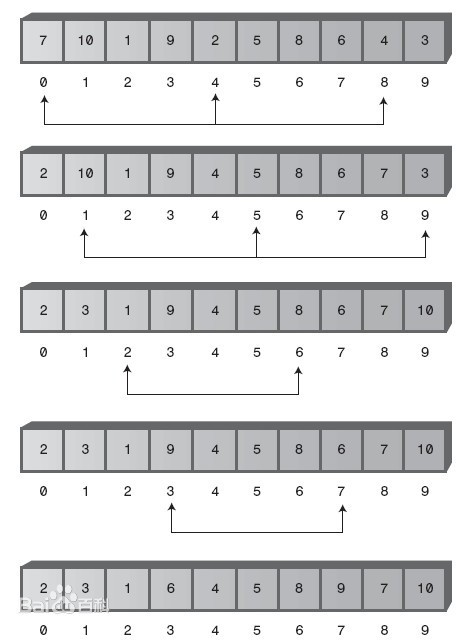
def shellSort(alist):
sublistcount = len(alist) // 2. Set interval
while sublistcount > 0:
for startposition in range(sublistcount):
gapInsertionSort(alist, startposition, sublistcount)
sublistcount = sublistcount // 2. Reducing the interval
def gapInsertionSort(alist, start, gap): #This function sorts the sublist
for i in range(start + gap, len(alist), gap):
currentValue = alist[i]
position = i
while position >= gap and alist[position - gap] > currentValue:
alist[position] = alist[position - gap]
position = position - gap
alist[position] = currentValue
testlist = [3, 8, 5, 9, 7, 2]
shellSort(testlist)
print(testlist)Merge sort
Merge sorting is a kind of divide and conquer strategy. It continuously splits the original list, and then sorts the two parts separately after splitting, and then merges them. It is a recursive idea. The time complexity is O(n), but it wastes twice the storage space.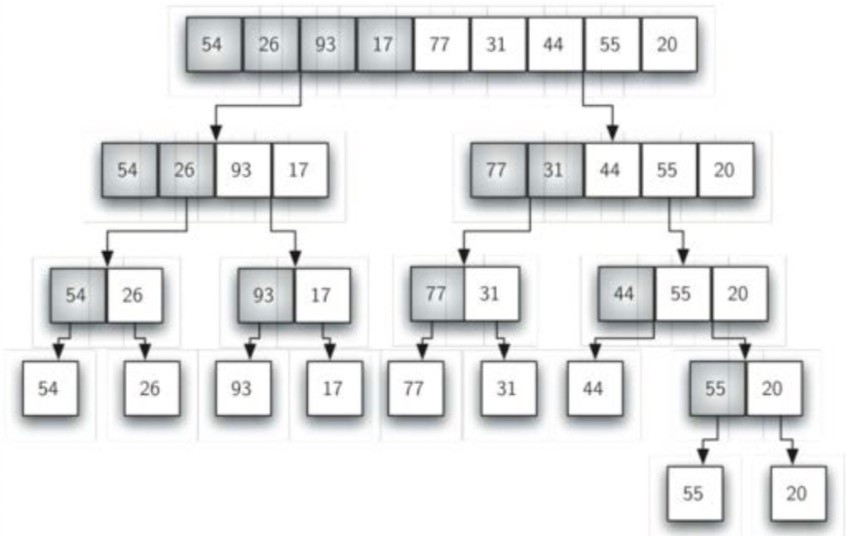
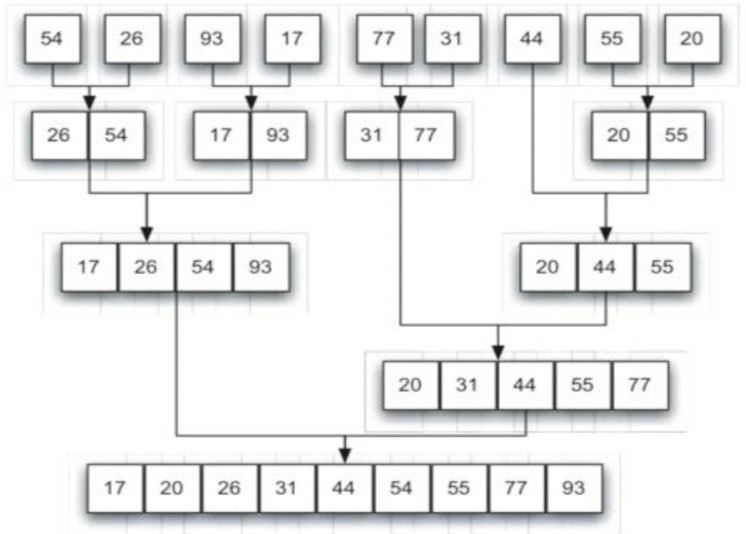
def mergeSort(alist):
if len(alist) > 1:
mid = len(alist) // 2
lefthalf = alist[:mid]
righthalf = alist[mid:]
mergeSort(lefthalf)
mergeSort(righthalf)
i = j = k = 0
while i < len(lefthalf) and j < len(righthalf):
if lefthalf[i] < righthalf[j]:
alist[k] = lefthalf[i]
i += 1
else:
alist[k] = righthalf[j]
j += 1
k += 1
while i < len(lefthalf):
alist[k] = lefthalf[i]
i += 1
k += 1
while j < len(righthalf):
alist[k] = righthalf[j]
j += 1
k += 1
testlist = [3, 8, 5, 9, 7, 2]
mergeSort(testlist)
print(testlist)Recursive solution of merging and sorting:
def merge_sort(alist):
if len(alist) <= 1:
return alist
mid = len(alist) // 2
left = alist[:mid]
right = alist[mid:]
return merge(merge_sort(left), merge_sort(right))
def merge(left, right):
result = []
while left and right:
if left[0] <= right[0]:
result.append(left.pop(0))
else:
result.append(right.pop(0))
result.extend(right if right else left)
return result
# testlist = [3, 8, 5, 9, 7, 2]
# print(merge_sort(testlist))Quick sort
Quick sort divides the original list into two parts (sorting and splitting) based on a "median" data item, and then sorts each part quickly.
The goal of the split is to find the "median", and the specific operations are as follows:
- Set the right side (next) of the first item to leftmark; set the left side (previous) to rightmark;
- Then the leftmark moves to the right, when it is larger than the first value, stop; rightmark moves to the left, when it is smaller than the first value, stop;
- Then data exchange between leftmark and rightmark;
- Then the leftmark and rightmark continue to move until the leftmark moves to the right of the rightmark;
- At this time, the location of rightmark should be the location of "median", and then exchange the first item with the data of rightmark;
If splitting can divide the data table into two equal parts, the complexity of splitting is O(logN); in extreme cases, its complexity will degenerate to O(n^2). The complexity of the whole comparison and movement is O(n); no additional storage space is needed in the whole process.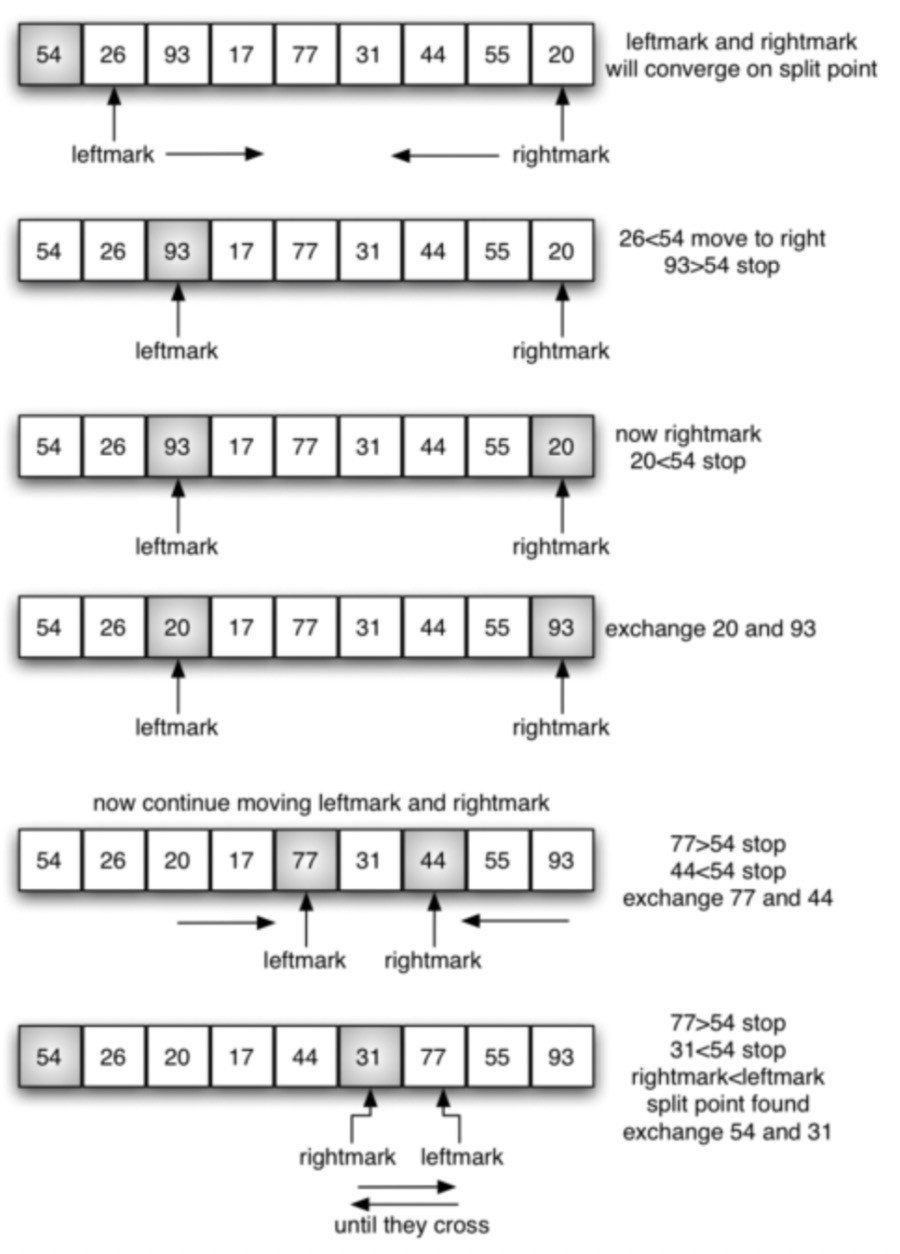
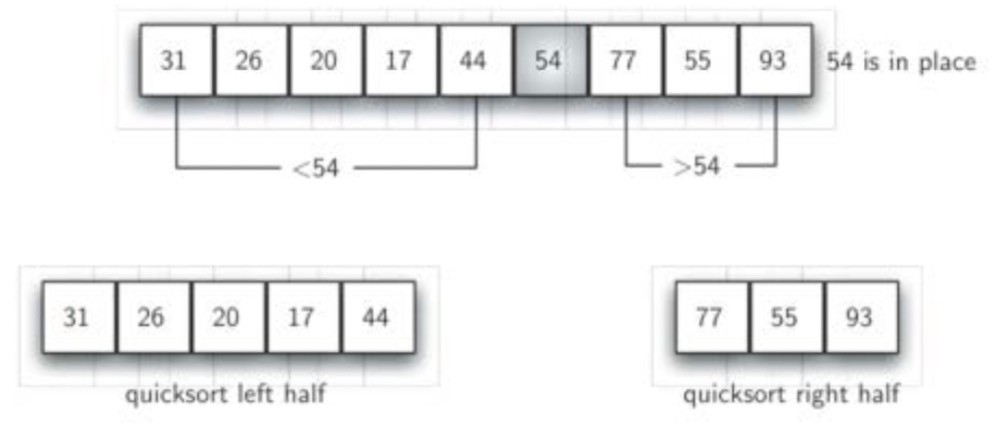
def partition(alist, first, last):
pivotvalue = alist[first]
leftmark = first + 1
rightmark = last
done = False
while not done:
while leftmark <= rightmark and alist[leftmark] <= pivotvalue:
leftmark = leftmark + 1
while rightmark >= leftmark and alist[rightmark] >= pivotvalue:
rightmark = rightmark -1
if rightmark < leftmark:
done = True
else:
alist[leftmark], alist[rightmark] = alist[rightmark], alist[leftmark]
alist[first], alist[rightmark] = alist[rightmark], alist[first]
return rightmark # At this time, rightmark points to the split point
def quickSortHelper(alist, first, last):
if first < last: # There must be at least two elements in the list to split
splitpoint = partition(alist, first, last)
quickSortHelper(alist, first, splitpoint - 1)
quickSortHelper(alist, splitpoint + 1, last)
def quickSort(alist):
quickSortHelper(alist, 0, len(alist)-1)
testlist = [3, 8, 5, 9, 7, 2]
quickSort(testlist)
print(testlist)